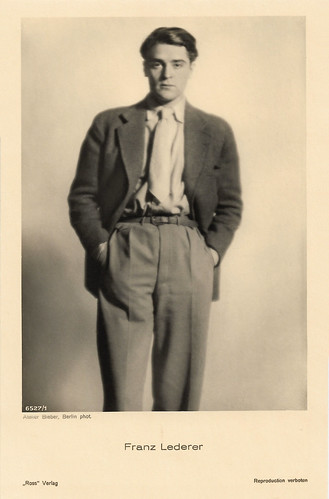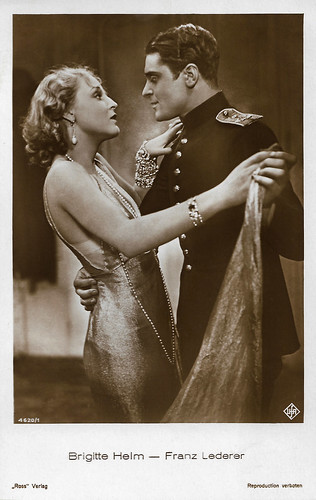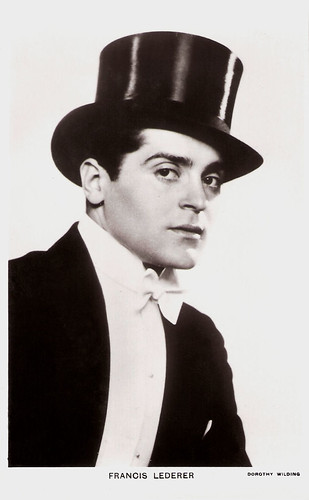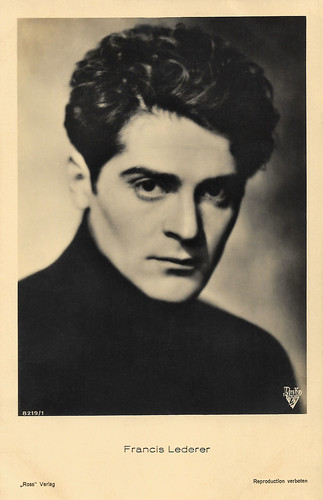Dark and gorgeous-looking actor Franz Lederer (1899–2000) had a successful film and stage career, first in Europe, then in the United States as Francis Lederer.

German postcard by Ross Verlag, no. 4055/1, 1929-1930. Photo: National.

German postcard by Ross Verlag, no. 100/2. Photo: Alex. Schmoll / HPF (Henny Porten Film). Henny Porten and Franz Lederer in Zuflucht/Refuge (Carl Froelich, 1928).

German postcard by Ross Verlag, no. 4221/1, 1929-1930. Photo: Ufa. Franz Lederer in Die wunderbare Lüge der Nina Petrowna/The Wonderful Lies of Nina Petrovna (Hanns Schwarz, 1929).

German postcard by Ross Verlag, no. 5435/1, 1930-1931. Photo: Atelier Gerstenburg, Berlin.

German postcard by Ross Verlag, no. 6527/1, 1931-1932. Photo: Bieber, Berlin.
Franz Lederer was born Frantisek Lederer in Prague, Austria-Hungary (now in the Czech Republic) in 1899. He was the son of Josef Lederer, a leather merchant and Rose Lederer. Young Frantisek began his working life as a department store delivery boy in Prague and fell in love with acting when he was young. He was trained at the Academy of Music and the Academy of Dramatic Arts in Prague.
Still a teenager, he served with the Czechoslovakian artillery during the first World War. He attained the rank of corporal. After military service, he became an apprentice with the New German Theatre in Prague. He made his stage debut with a walk-on in the play 'Burning Heart'. He toured Moravia and central Europe, making a name for himself as a matinee idol in theatres in Czechoslovakia, Hungary, Austria and Germany.
Because of his stunningly handsome looks, it took some time for the critics to take Lederer seriously. Notable among his performances was a turn as Romeo in theatre legend Max Reinhardt's staging of 'Romeo and Juliet'. In the late 1920s, Franz Lederer was lured into films by the German actress Henny Porten and her producer husband. He appeared with her in the melodrama Zuflucht/Refuge (Carl Froelich, 1928).
For director Georg Wilhelm Pabst, he performed in Die Büchse der Pandora/Pandora's Box (G.W. Pabst, 1929) as a young man who, along with his father (Fritz Kortner), becomes obsessed with the hauntingly beautiful dancer Lulu (Louise Brooks).
He also appeared in Atlantik/Atlantic (Ewald André Dupont, 1929). Dashingly garbed in military costume, he was also notable in the lush and poignant romantic drama Die wunderbare Lüge der Nina Petrowna/The Wonderful Lie of Nina Petrovna (Hanns Schwarz, 1929) with Brigitte Helm. Franz Lederer easily made the transition from silent to sound film and seemed to be on his way to becoming one of Europe's top male film stars.

German postcard by Ross Verlag, no. 100/1. Photo: Alex. Schmoll / HPF (Henny Porten Film) Henny Porten and Franz Lederer in Zuflucht/Refuge (Carl Froelich, 1928).

German postcard by Ross Verlag, no. 4385/1, 1929-1930. Photo: Atelier Binder, Berlin.

German postcard by Ross Verlag, no. 4620/1, 1929-1930. Photo: Ufa. Brigitte Helm and Franz Lederer in Die wunderbare Lüge der Nina Petrowna/The Wonderful Lies of Nina Petrovna (Hanns Schwarz, 1929).

German postcard by Ross Verlag, no. 5373/1, 1930-1931. Franz Lederer and Anita Mey in an unidentified film.

Austrian postcard by Iris-Verlag, no. 5834. Photo: Exelsior-Film / Allianz-Film. Franz Lederer and Camilla Horn in Fundvogel/Paradise Bird (Wolfgang Hoffmann-Harnisch, 1930).
In London’s West End, Franz Lederer performed on stage in 'Volpone' (1931) and in 'Autumn Crocus' (1932). He performed the latter play also on Broadway, where it played for 210 performances in 1932 and 1933. He used Francis Lederer as his stage name now. He also performed 'Autumn Crocus' in Los Angeles, where his performances attracted film offers from Hollywood. With the deteriorating political situation in Europe, Lederer decided to stay in the United States.
It was MGM producer Irving Thalberg's plan to make him ‘the biggest star in Hollywood', but the death of Thalberg ended that plan, and Lederer didn't quite catch on as an American star.
Lederer's American movies were fairly light fare such as Man of Two Worlds (J. Walter Ruben, 1934) with Elissa Landi, Romance in Manhattan (Stephen Roberts, 1934) with Ginger Rogers, The Gay Deception (William Wyler, 1935) with Frances Dee, and One Rainy Afternoon (Rowland V. Lee, 1936).
Lederer became a U.S. citizen in 1939. That year, he starred as a lady-killer playboy in the Billy Wilder scripted Midnight (Mitchell Leisen, 1939) with Claudette Colbert and John Barrymore.
Hal Erickson writes at AllMovie: “His cinematic stock in trade at the time was the outgoing, slightly naïve foreigner at the mercy of aggressive, acrimonious Americans or Brits. One of his best screen characterizations was the disgruntled German-American ‘bundist’ in Confessions of a Nazi Spy (Anatole Litvak, 1939), which won him the personal praise of his co-star Edward G. Robinson, who wasn't accustomed to handing out empty compliments.” He also earned plaudits for his portrayal of the fascist to whom Joan Bennett finds herself wed in The Man I Married (Irving Pichel, 1940).

Austrian postcard by Iris-Verlag, no. 5795. Photo: Nero Film, Mondial Film.

German postcard by Ross Verlag, no. 4660/1, 1929-1930. Photo: Hanni Schwarz.

German postcard by Ross Verlag, no. 5856/1. 1930-1931. Photo: Aafa Film.

British postcard in the Picturegoer series, London no. 763. Photo: Dorothy Wilding.

British postcard. Photo: Paramount. Publicity still for The Pursuit of Happiness (Alexander Hall, 1934).
Throughout his career, Francis Lederer often performed on stage, both in New York and elsewhere. He appeared in productions of 'Golden Boy' (1937), 'Seventh Heaven' (1939), 'No Time for Comedy' (1939), in which he replaced Laurence Olivier, 'The Play's the Thing' (1942), 'A Doll's House' (1944), 'Arms and the Man' (1950), 'The Sleeping Prince' (1956) and 'The Diary of Anne Frank' (1958) as Anne’s father.
Although he took a break from making films in 1941 to concentrate on his stage work, he returned to the silver screen in 1944, appearing in The Bridge of San Luis Rey (Rowland V. Lee, 1944), and the bizarre and fascinating version of the downbeat satirical drama Diary of a Chambermaid (Jean Renoir, 1946).
After making Surrender (Allan Dwan, 1950), he took another break from Hollywood but returned once more in 1956 with Lisbon (Ray Milland, 1956). He also played a world-weary Count Dracula for The Return of Dracula (Paul Landres, 1958). Cavett Binion at AllMovie reviews: “Played refreshingly straight, this modest Universal production benefits from Lederer's compelling performance as the seductive Count and several unique plot twists (including a blind girl who becomes sighted on turning into a vampire).”
His final film appearance was in Terror Is a Man (Gerardo de Leon, 1959). He would continue to make television appearances for the next ten years in such shows as The Untouchables (1960), Mission: Impossible (1967) and That Girl (1967). His final television appearance occurred in a 1971 episode of Rod Serling's Night Gallery. Lederer had become very wealthy by investing in real estate. He was active in local and Los Angeles civic affairs, philanthropy and politics. In 2000, he was honoured with the Cross of Honor for Science and Arts, First Class, by the Austrian government.
Lederer married three times. His first marriage was to Ada Nejedly during the 1920s. In 1937, he married Mexican American actress and dancer Margo. They divorced in 1940. His third marriage was to Marion Irvine in 1941. Irvine served as Los Angeles' Commissioner of Cultural Affairs. Their marriage lasted 59 years. Francis Lederer worked as a teacher up until the week before he died in Palm Springs, USA, in 2000. He was 100.

German postcard by Ross Verlag, no. 8219/1, 1933-1934. Photo: Radio Pictures.

British postcard in the Film Shots series by Film Weekly. Photo: Radio (RKO). Steffi Duna and Francis Lederer in Man of Two Worlds (J. Walter Ruben, 1934).

British postcard by Real Photograph, no. 763a. Photo: Paramount.

British postcard in the Picturegoer series, London no. 763b. Photo: United Artists.

Small Czech collectors card by Pressfoto, Praha (Prague), no. S 56/9, 1964.

Verso of the cover of Illustrierter Film-Kurier, XII, 1930, no. 1460. Truus van Aalten and Franz Lederer in the German early sound comedy Susanne macht Ordnung (Eugen Thiele, 1930).
Scene from Die wunderbare Lüge der Nina Petrowna/The Wonderful Lie of Nina Petrovna (1929). Source: Radio Santos (YouTube).
Sources: Hal Erickson (AllMovie - Page now defunct), Cavett Binion (AllMovie - Page now defunct), Christopherbkk (IMDb), TCM (Page now defunct), Wikipedia and IMDb.
This post was last updated on 10 March 2025.

German postcard by Ross Verlag, no. 4055/1, 1929-1930. Photo: National.

German postcard by Ross Verlag, no. 100/2. Photo: Alex. Schmoll / HPF (Henny Porten Film). Henny Porten and Franz Lederer in Zuflucht/Refuge (Carl Froelich, 1928).

German postcard by Ross Verlag, no. 4221/1, 1929-1930. Photo: Ufa. Franz Lederer in Die wunderbare Lüge der Nina Petrowna/The Wonderful Lies of Nina Petrovna (Hanns Schwarz, 1929).

German postcard by Ross Verlag, no. 5435/1, 1930-1931. Photo: Atelier Gerstenburg, Berlin.

German postcard by Ross Verlag, no. 6527/1, 1931-1932. Photo: Bieber, Berlin.
Matinee idol
Franz Lederer was born Frantisek Lederer in Prague, Austria-Hungary (now in the Czech Republic) in 1899. He was the son of Josef Lederer, a leather merchant and Rose Lederer. Young Frantisek began his working life as a department store delivery boy in Prague and fell in love with acting when he was young. He was trained at the Academy of Music and the Academy of Dramatic Arts in Prague.
Still a teenager, he served with the Czechoslovakian artillery during the first World War. He attained the rank of corporal. After military service, he became an apprentice with the New German Theatre in Prague. He made his stage debut with a walk-on in the play 'Burning Heart'. He toured Moravia and central Europe, making a name for himself as a matinee idol in theatres in Czechoslovakia, Hungary, Austria and Germany.
Because of his stunningly handsome looks, it took some time for the critics to take Lederer seriously. Notable among his performances was a turn as Romeo in theatre legend Max Reinhardt's staging of 'Romeo and Juliet'. In the late 1920s, Franz Lederer was lured into films by the German actress Henny Porten and her producer husband. He appeared with her in the melodrama Zuflucht/Refuge (Carl Froelich, 1928).
For director Georg Wilhelm Pabst, he performed in Die Büchse der Pandora/Pandora's Box (G.W. Pabst, 1929) as a young man who, along with his father (Fritz Kortner), becomes obsessed with the hauntingly beautiful dancer Lulu (Louise Brooks).
He also appeared in Atlantik/Atlantic (Ewald André Dupont, 1929). Dashingly garbed in military costume, he was also notable in the lush and poignant romantic drama Die wunderbare Lüge der Nina Petrowna/The Wonderful Lie of Nina Petrovna (Hanns Schwarz, 1929) with Brigitte Helm. Franz Lederer easily made the transition from silent to sound film and seemed to be on his way to becoming one of Europe's top male film stars.

German postcard by Ross Verlag, no. 100/1. Photo: Alex. Schmoll / HPF (Henny Porten Film) Henny Porten and Franz Lederer in Zuflucht/Refuge (Carl Froelich, 1928).

German postcard by Ross Verlag, no. 4385/1, 1929-1930. Photo: Atelier Binder, Berlin.

German postcard by Ross Verlag, no. 4620/1, 1929-1930. Photo: Ufa. Brigitte Helm and Franz Lederer in Die wunderbare Lüge der Nina Petrowna/The Wonderful Lies of Nina Petrovna (Hanns Schwarz, 1929).

German postcard by Ross Verlag, no. 5373/1, 1930-1931. Franz Lederer and Anita Mey in an unidentified film.

Austrian postcard by Iris-Verlag, no. 5834. Photo: Exelsior-Film / Allianz-Film. Franz Lederer and Camilla Horn in Fundvogel/Paradise Bird (Wolfgang Hoffmann-Harnisch, 1930).
The biggest star in Hollywood
In London’s West End, Franz Lederer performed on stage in 'Volpone' (1931) and in 'Autumn Crocus' (1932). He performed the latter play also on Broadway, where it played for 210 performances in 1932 and 1933. He used Francis Lederer as his stage name now. He also performed 'Autumn Crocus' in Los Angeles, where his performances attracted film offers from Hollywood. With the deteriorating political situation in Europe, Lederer decided to stay in the United States.
It was MGM producer Irving Thalberg's plan to make him ‘the biggest star in Hollywood', but the death of Thalberg ended that plan, and Lederer didn't quite catch on as an American star.
Lederer's American movies were fairly light fare such as Man of Two Worlds (J. Walter Ruben, 1934) with Elissa Landi, Romance in Manhattan (Stephen Roberts, 1934) with Ginger Rogers, The Gay Deception (William Wyler, 1935) with Frances Dee, and One Rainy Afternoon (Rowland V. Lee, 1936).
Lederer became a U.S. citizen in 1939. That year, he starred as a lady-killer playboy in the Billy Wilder scripted Midnight (Mitchell Leisen, 1939) with Claudette Colbert and John Barrymore.
Hal Erickson writes at AllMovie: “His cinematic stock in trade at the time was the outgoing, slightly naïve foreigner at the mercy of aggressive, acrimonious Americans or Brits. One of his best screen characterizations was the disgruntled German-American ‘bundist’ in Confessions of a Nazi Spy (Anatole Litvak, 1939), which won him the personal praise of his co-star Edward G. Robinson, who wasn't accustomed to handing out empty compliments.” He also earned plaudits for his portrayal of the fascist to whom Joan Bennett finds herself wed in The Man I Married (Irving Pichel, 1940).

Austrian postcard by Iris-Verlag, no. 5795. Photo: Nero Film, Mondial Film.

German postcard by Ross Verlag, no. 4660/1, 1929-1930. Photo: Hanni Schwarz.

German postcard by Ross Verlag, no. 5856/1. 1930-1931. Photo: Aafa Film.

British postcard in the Picturegoer series, London no. 763. Photo: Dorothy Wilding.

British postcard. Photo: Paramount. Publicity still for The Pursuit of Happiness (Alexander Hall, 1934).
A world weary Count Dracula
Throughout his career, Francis Lederer often performed on stage, both in New York and elsewhere. He appeared in productions of 'Golden Boy' (1937), 'Seventh Heaven' (1939), 'No Time for Comedy' (1939), in which he replaced Laurence Olivier, 'The Play's the Thing' (1942), 'A Doll's House' (1944), 'Arms and the Man' (1950), 'The Sleeping Prince' (1956) and 'The Diary of Anne Frank' (1958) as Anne’s father.
Although he took a break from making films in 1941 to concentrate on his stage work, he returned to the silver screen in 1944, appearing in The Bridge of San Luis Rey (Rowland V. Lee, 1944), and the bizarre and fascinating version of the downbeat satirical drama Diary of a Chambermaid (Jean Renoir, 1946).
After making Surrender (Allan Dwan, 1950), he took another break from Hollywood but returned once more in 1956 with Lisbon (Ray Milland, 1956). He also played a world-weary Count Dracula for The Return of Dracula (Paul Landres, 1958). Cavett Binion at AllMovie reviews: “Played refreshingly straight, this modest Universal production benefits from Lederer's compelling performance as the seductive Count and several unique plot twists (including a blind girl who becomes sighted on turning into a vampire).”
His final film appearance was in Terror Is a Man (Gerardo de Leon, 1959). He would continue to make television appearances for the next ten years in such shows as The Untouchables (1960), Mission: Impossible (1967) and That Girl (1967). His final television appearance occurred in a 1971 episode of Rod Serling's Night Gallery. Lederer had become very wealthy by investing in real estate. He was active in local and Los Angeles civic affairs, philanthropy and politics. In 2000, he was honoured with the Cross of Honor for Science and Arts, First Class, by the Austrian government.
Lederer married three times. His first marriage was to Ada Nejedly during the 1920s. In 1937, he married Mexican American actress and dancer Margo. They divorced in 1940. His third marriage was to Marion Irvine in 1941. Irvine served as Los Angeles' Commissioner of Cultural Affairs. Their marriage lasted 59 years. Francis Lederer worked as a teacher up until the week before he died in Palm Springs, USA, in 2000. He was 100.

German postcard by Ross Verlag, no. 8219/1, 1933-1934. Photo: Radio Pictures.

British postcard in the Film Shots series by Film Weekly. Photo: Radio (RKO). Steffi Duna and Francis Lederer in Man of Two Worlds (J. Walter Ruben, 1934).

British postcard by Real Photograph, no. 763a. Photo: Paramount.

British postcard in the Picturegoer series, London no. 763b. Photo: United Artists.

Small Czech collectors card by Pressfoto, Praha (Prague), no. S 56/9, 1964.

Verso of the cover of Illustrierter Film-Kurier, XII, 1930, no. 1460. Truus van Aalten and Franz Lederer in the German early sound comedy Susanne macht Ordnung (Eugen Thiele, 1930).
Scene from Die wunderbare Lüge der Nina Petrowna/The Wonderful Lie of Nina Petrovna (1929). Source: Radio Santos (YouTube).
Sources: Hal Erickson (AllMovie - Page now defunct), Cavett Binion (AllMovie - Page now defunct), Christopherbkk (IMDb), TCM (Page now defunct), Wikipedia and IMDb.
This post was last updated on 10 March 2025.
No comments:
Post a Comment